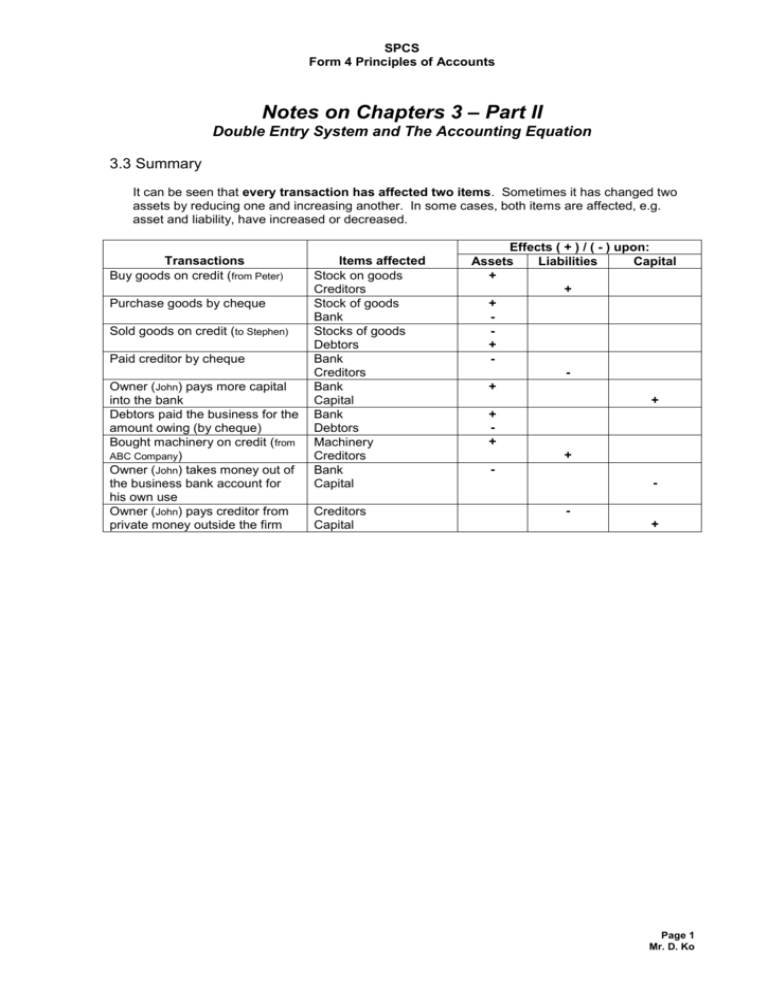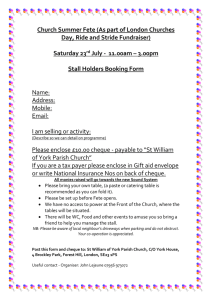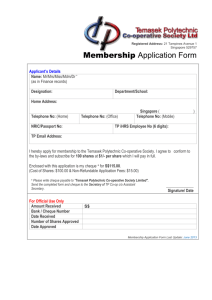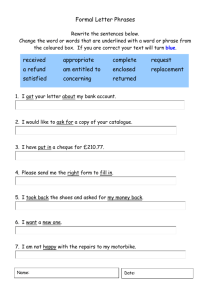Double entry principles and the accounting equation (Part 2)
advertisement

SPCS Form 4 Principles of Accounts Notes on Chapters 3 – Part II Double Entry System and The Accounting Equation 3.3 Summary It can be seen that every transaction has affected two items. Sometimes it has changed two assets by reducing one and increasing another. In some cases, both items are affected, e.g. asset and liability, have increased or decreased. Transactions Buy goods on credit (from Peter) Purchase goods by cheque Sold goods on credit (to Stephen) Paid creditor by cheque Owner (John) pays more capital into the bank Debtors paid the business for the amount owing (by cheque) Bought machinery on credit (from ABC Company) Owner (John) takes money out of the business bank account for his own use Owner (John) pays creditor from private money outside the firm Items affected Stock on goods Creditors Stock of goods Bank Stocks of goods Debtors Bank Creditors Bank Capital Bank Debtors Machinery Creditors Bank Capital Creditors Capital Effects ( + ) / ( - ) upon: Assets Liabilities Capital + + + + + + + + + + Page 1 Mr. D. Ko SPCS Form 4 Principles of Accounts 3.4 Exercise A Transactions (1) Started an engineering business putting $5,000 into a business (2) Purchase of stock on credit from Unique Machines for $1,350 (3) Withdrew $150 from the bank and placed them in the cash box (4) Sold some stocks for $150 on credit to Tai Wah Company Ltd. (5) Returned some of the stock, valued at $200 to Unique Machines (6) Tai Wah pays the firm the amount owing, $150 (7) Paid the amount of $300 to Unique Machines by cheque Items affected Bank Capital Effects ( + ) / ( - ) upon: Assets Liabilities Capital + + Stock of goods Creditors [Unique Machines] Bank Cash in hand Stock of goods Debtors [Tai Wah Co. Ltd] Stock of goods Creditors + Bank Debtors Bank Creditors + - + + + - - (1) Assets Cash at bank XXX Balance Sheet as at YYY $ Capital & Liabilities 5,000.00 Capital 5,000.00 $ 5,000.00 5,000.00 XXX Balance Sheet as at YYY $ Capital & Liabilities 1,350.00 Capital 5,000.00 Creditor [Unique Machine] 6,350.00 $ 5,000.00 1,350.00 6,350.00 (2) Assets Stock of goods Cash at bank (3) Assets Stock of goods Cash at bank Cash in hand XXX Balance Sheet as at YYY $ Capital & Liabilities 1,350.00 Capital 4,850.00 Creditor [Unique Machine] 150.00 6,350.00 $ 5,000.00 1,350.00 6,350.00 Page 2 Mr. D. Ko SPCS Form 4 Principles of Accounts (4) Assets Stock of goods Debtor [Tai Wah] Cash at bank Cash in hand XXX Balance Sheet as at YYY $ Capital & Liabilities 1,200.00 Capital 150.00 Creditor [Unique Machine] 4,850.00 150.00 $ 5,000.00 1,350.00 6,350.00 6,350.00 XXX Balance Sheet as at YYY $ Capital & Liabilities 1,000.00 Capital 150.00 Creditor [Unique Machine] 4,850.00 150.00 $ 5,000.00 1,150.00 6,150.00 6,150.00 XXX Balance Sheet as at YYY $ Capital & Liabilities 1,000.00 Capital 0.00 Creditor [Unique Machine] 5,000.00 150.00 $ 5,000.00 1,150.00 6,150.00 6,150.00 (5) Assets Stock of goods Debtor [Tai Wah] Cash at bank Cash in hand (6) Assets Stock of goods Debtor [Tai Wah] Cash at bank Cash in hand (7) Assets Stock of goods Cash at bank Cash in hand XXX Balance Sheet as at YYY $ Capital & Liabilities 1,000.00 Capital 4,700.00 Creditor [Unique Machine] 150.00 5,850.00 $ 5,000.00 850.00 5,850.00 Page 3 Mr. D. Ko SPCS Form 4 Principles of Accounts 3.5 Exercise B Here is the balance sheet of C. Ko at the close of business on 31 May 2003: Assets Fixtures Motor vehicles Stock of goods Debtors Cash at bank C. Ko Balance Sheet as at 31 May 2003 $ Capital & Liabilities 8,700.00 Capital 18,500.00 Creditors 6,300.00 2,400.00 8,100.00 44,000.00 $ 41,500.00 2,500.00 44,000.00 The following transactions occurred on 1 June 2003: (1) Bought extra fixtures on credit for $200. (2) Bought an extra motor van paying by cheque immediately for $6,500. (3) Debtors paid us by cheque for $900. (4) Paid to creditors by cheque for $700. (5) C. Ko brought in extra capital, paid into bank for $2000. (6) Purchase of stock by cheque for $300. (7) Purchase of stock on credit for $800. The closing amount of each asset account on the Balance Sheet comes from the individual ledger (closing) balance of each ledger account. Page 4 Mr. D. Ko SPCS Form 4 Principles of Accounts 3.6 The Double Entry System We have seen that every transaction affects two items. If we have to show the effect of every transaction when we are doing our bookkeeping, we will have to show the effect of a transaction on each of the two items. In 2.4 Exercise A, we drew up a new balance sheet after each transaction. You can do this easily if you have only a few transactions per day. But if there are hundreds of transactions each day, it will become impossible for you to draw up hundreds of different balance sheets. Instead of constantly drawing up amended balance sheets after each transaction, what we have is the double entry system. The basis for this system is that the transactions which have occurred are entered in a set of ‘accounts’. An account is a place in our books where all the information referring to a particular asset, liability or capital, is entered. Thus there will be an account for motor vans, where all transactions concerning motor vans will be entered. This will be extended so that every asset, every liability and capital will have its own account, for transactions in that item. New Terms: Double entry bookkeeping: - A system by which each transaction is entered twice. Account: - Part of double entry records, containing details of transactions for a specific item. Page 5 Mr. D. Ko SPCS Form 4 Principles of Accounts 3.7 The Accounts for Double Entry Each account can be shown on a separate page. The double entry system divides each page into TWO halves. The left-hand side of each page is called the debit while the right-hand side is called the credit side. The title of each account is written across the top of the account at the centre as shown below. Date Particulars Title of account $ Date This is the DEBIT (Dr) side Particulars $ This is the CREDIT (Cr) side 3.8 Double Entry Rules Since transactions were to increase or decrease assets, liabilities or capital, the double entry rules for accounts are: T- account Assets Liabilities Capital Assets Liabilities Capital Let us look at the accounting equation: To increase each item To decrease each item Assets = Debit Credit Liabilities Credit Debit + Capital Credit Debit Steps for making correct double entry: (1) Decide which TWO items are affected. (2) Classify which category that each of the TWO items belongs to. (i.e. assets, liabilities or capital) (3) Decide whether they are increasing or decreasing in their own category. (4) Apply the rule and complete the double entry. Example 1: On 31 May 2003, John paid cash $2,000.00 to buy machinery. (1) Which 2 items are affected? (a) CASH and (b) MACHINERY (2) What are their categories? (a) CASH = assets / liabilities / capital (b) MACHINERY = assets / liabilities / capital (3) Are they increasing or decreasing in their respective category? Page 6 Mr. D. Ko SPCS Form 4 Principles of Accounts (a) CASH is a kind of ASSET which is increasing / decreasing. (b) MACHINERY is a kind of ASSET which is increasing / decreasing. (4) Apply the rule and complete the double entry. Date Cash $ Date Particulars May 31 Date Particulars May 31 Cash Machinery $ Date Particulars $ Machinery 2000 Particulars $ 2000 3.9 Exercise A Complete the table below and write down the transactions in account form. The first one has been done for you as an example. Date Transactions (A) 2004 May 1 (B) May 3 Started an engineering business putting $1000 into a business bank account. Bought machinery on credit from Unique Machines $275. (C) May 4 (D) May 7 (E) May 10 (F) May 21 Returned some of the machinery, value $27, to Unique Machines. (G) May 28 S. Au paid the firm the amount owing, $15, by cheque. (H) May 30 (I) May 31 Bought another motor van, paying by cheque $420. Paid the amount of $248 to Unique Machines by cheque. Withdrew $200 cash from the bank and placed it in the cash box. Bought a motor van, paying in cash $180. Sold some of the machinery for $15 on credit to S. Au. Effect Increases asset of bank Increases capital of owner Action Dr: Bank account Cr: Capital account Increases asset of machinery Increases liability to Unique Machines Increases asset of cash Decreases asset of bank Increases asset of motor van Decreases asset of cash Increases asset of money owing by S. Au Decreases asset of machinery Decreases liability to Unique Machines Decreases asset of machinery Increases asset of bank Decreases asset of money owing by S. Au Increases asset of motor van Decreases asset of bank Decreases liability to Unique Machines Decreases asset of bank Dr: Machinery a/c Cr: Unique Machines a/c Dr: Cash a/c Cr: Bank a/c Dr: Motor Van a/c Cr: Cash a/c Dr: S. Au’s a/c Cr: Machinery a/c Dr: Unique Machines a/c Cr: Machinery a/c Dr: Bank a/c Cr: S. Au’s a/c Dr: Motor Van a/c Cr: Bank a/c Dr: Unique Machines a/c Cr: Bank a/c Page 7 Mr. D. Ko SPCS Form 4 Principles of Accounts Exercise B Write up the asset, liability and capital accounts to record the following transactions in the records of K. Wong. 2003 Jul. “ “ “ “ “ “ “ 1 2 3 5 8 15 23 31 Started business with $2,500 in the bank. Bought office furniture by cheque for $150. Bought machinery for $750 on credit from Planners Ltd. Bought a motor van, paying by cheque $600. Sold some of the office furniture – not suitable for the firm – for $60 on credit to L. Sam. Paid the amount owing to Planners Ltd. of $750 by cheque. Received the amount due from L. Sam $60 in cash. Bought more machinery by cheque for $280. Exercise C Write down the various accounts needed in the books of P. Tsang to record the following transactions: 2003 Aug. “ “ “ “ “ “ 1 3 6 8 11 12 15 “ “ 17 19 “ “ “ “ “ “ 21 22 23 26 28 30 Opened business with $10,000 in the bank. Bought office equipment for $7,000 on credit from Viva Machinery Limited. Bought a motor van paying by cheque for $3,000. Borrowed the money from H. Chen – he gave us the money by cheque. Tsang put further capital into the firm in the form of $5,000 cash. Transfer $350 from the bank account to the bank account. Returned some of the office equipment costing $200 – it was faulty – to Viva Machinery Limited Bought more office equipment, paying $50 cash. Sold the motor van, because it was unsuitable, to L. Jim for $3000. L. Jim will settle for this by three payments later this month. Received a $400 loan in cash from T. Hung. L. Jim paid us a cheque for $1000. Bought a suitable motor van for $3600 on credit from Ideas & Promotion Ltd. L. Jim paid us a cheque for $1800. Paid $2000 by cheque to Ideas & Promotion Ltd. L. Jim paid us $200 cash. FP: Exercise D Write up the accounts of T. Hip to record the following transactions: 2003 Mar. “ 1 2 “ “ “ “ “ “ “ 3 5 8 15 17 24 31 Started business with $1,000 cash. Received a loan of $5,000 from M. Chow by cheque, a bank account being opened and the cheque paid into it. Bought machinery for $60 cash. Bought display equipment on credit from Betterview Machines for $550. Took $300 out of the bank and put it into the cash till. Repaid part of Chow’s loan by cheque for $800. Paid amount owing to Betterview Machines of $550 by cheque. Repaid part of Chow’s loan by $100 cash. Bought additional machinery, this time on credit from D. Sun for $500. From the details above, draw up the balance sheet of T. Hip as at 31 March 2003. FP: Exercise E From the details given in Exercise B, draw up the balance sheet of K. Wong as at 31 July 2003. Page 8 Mr. D. Ko







